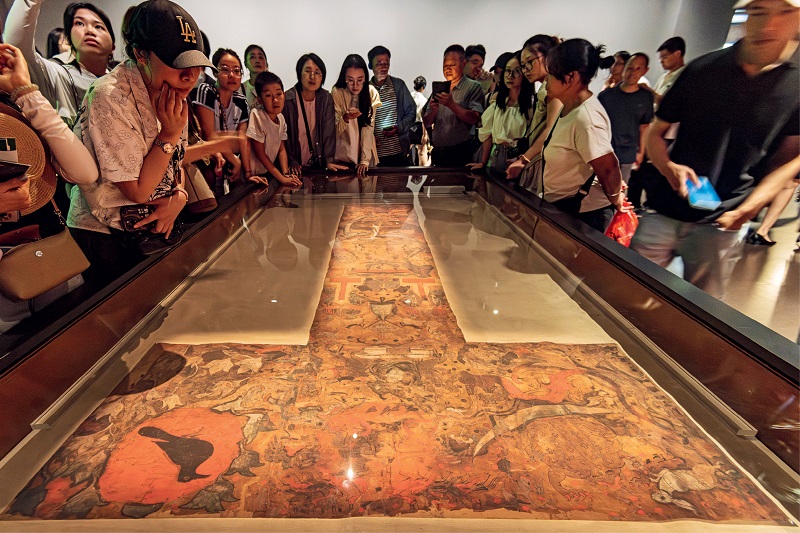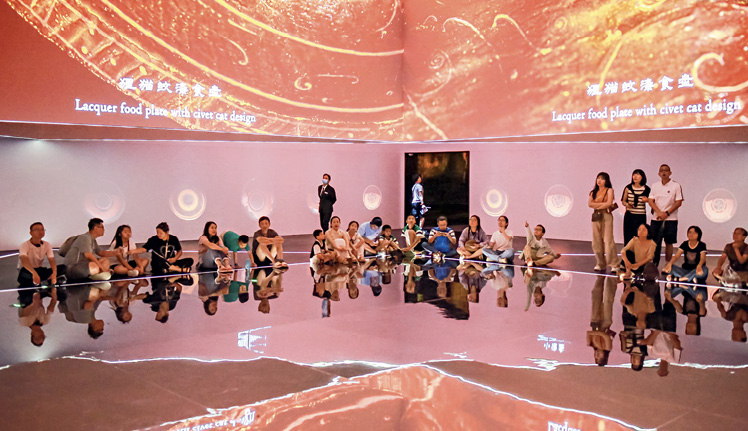The cultural relics on display at this museum have become a window for visitors to get a glimpse of Chinese civilization thousands of years ago.

Visitors admire a T-shaped painting on silk from Li Xi’s tomb at the Hunan Museum on September 11, 2024.
The Hunan Museum in Changsha is the largest history museum in Hunan Province. It houses over 570,000 items in its collection, featuring relics from the Mawangdui Han Dynasty Tombs, bronzeware from the Shang (1600 B.C.-1046 B.C.) and Zhou (1046 B.C.-256 B.C.) dynasties, Chu State historical artifacts, and other objects.
The “Changsha Mawangdui Han Dynasty Tombs Exhibition” and “Hunanese – Exhibition of Hunan History and Culture” are the two permanent exhibitions. The former displays relics unearthed from the tombs of Licang — the highest-ranking official of the Changsha State during the early Western Han Dynasty (206 B.C.-24 A.D.) — and his relatives, while the latter demonstrates the lifestyle and customs practiced by Hunan people throughout history.
The exhibition on the Mawangdui Han Dynasty Tombs is the highlight of the museum. The excavation of the tombs at Mawangdui, Changsha, which took place between 1972 and 1974, was among the most significant archaeological discoveries of the 20th century. The well-preserved tomb structure as well as the wealth of funerary items unearthed reveal details of everyday life and social norms during the Han Dynasty (206 – 220 B.C.).
Nearly 3,000 people worldwide were or are engaged in the study of artifacts unearthed from the Mawangdui Han Dynasty Tombs. At the Chinese Art Media Labat (CAMLab) of Harvard University, there is a research group dedicated to the culture and art of the Mawangdui tombs. "From a global perspective, the cultural heritage of Mawangdui can been seen as a pinnacle. It not only enhances the world’s understanding of ancient Chinese civilization but also promotes exchanges between the East and the West in the fields of archaeology and art research," said Eugene Wang, the founding director of Harvard FAS CAMLab.

A bronze ding, or vessel for food with a human mask design, a national treasure, at the Hunan Museum.
A Noblewoman of 2,000 Years Ago
The Mawangdui Tomb No.1 contained the world’s first-known well-preserved human body that is not mummified. The tomb was of Xin Zhui, wife of Changsha State’s Prime Minister Li Cang in the Western Han Dynasty who lived in the second century B.C.
Due to the special embalming techniques and conditions of the soil, her body has remained remarkably well-preserved for over 2,000 years. Her eyelashes and skin pores are visible, and her skin still retains elasticity, making Xin Zhui specially valuable for medical and anthropological research. A modern medical report revealed that Xin Zhui died from a heart attack at the age of 56.
The Hunan Museum has established a tech-assisted system for preserving her body by utilizing cooling systems, liquid immersion techniques, and air purification systems. Today, visitors can view Xin Zhui’s preserved remains in the museum.
Xin Zhui was a woman who loved to dress well, and seemed fond of wearing makeup and luxurious clothing. An exquisite makeup container was unearthed from her tomb, containing nine smaller cases of various shapes, each holding a different type of beauty product. Among them is a circular-shaped powder pad, made of silk and cotton, which is nearly identical to its modern version today. The craft for making wigs also closely resembled modern techniques.
Many intact silk garments were unearthed from the tomb, but the most astonishing discovery was an unlined gauze gown, weighing just 49 grams while measuring an astonishing 2.6 square meters. This masterpiece represents the pinnacle of Western Han textile techniques. Though plain and simple, this garment showcases the extraordinary craftsmanship of its time. Other funerary items included rare jewelry such as crystal, coral, agate, and pearl ornaments, which were transported to the region via the Silk Road.
An inventory of the funerary objects found in Xin Zhui’s tomb records over 80 dishes, including several cases of grilled skewers. These dishes were prepared using various cooking methods such as stewing, boiling, frying, steaming, and grilling, and involved a dozen condiments, including sugar, salt, and sauces. During the excavation, slices of lotus root which had been used in soup were still clearly identifiable in a lacquer vessel.
The burial items also included a variety of lacquered wooden tableware. Some had inscriptions on their bottoms, which, in modern terms, can be translated as "Enjoy your meal." Nearly 30 lacquered food containers have cat patterns, making them the earliest known visual depictions of cats in China. This is attributed to the generally low furniture used during the Han Dynasty. To prevent rat infestations, ancient people painted images of cats on tableware, hoping to deter rodents.
The T-shaped silk painting on her coffin is also exquisite. Duan Xiaoming, director of the Hunan Museum, explained that the three sections of the painting depict heaven, earth, and the underworld from top to bottom respectively. Its patterns are emblematic of ancient people’s imagination of the universe and their pursuit of immortality.
The tomb of Xin Zhui vividly showcases the dietary customs, rituals, and refined lifestyle of the early Western Han period. Duan pointed out, “From a modern perspective, the food, clothing, and lifestyle of Xin Zhui may seem very different from us, but the continuity in ethos and the relentless pursuit of a better life remain the same.”

Xin Zhui’s remains at the “Changsha Mawangdui Han Dynasty Tombs Exhibition” at the Hunan Museum.
The Underground Library
Tomb No. 3 at Mawangdui was of a young senior military officer, Li Xi, an avid reader who loved honing his skills with all kinds of weapons. A large collection of military texts, maps, and weapons were discovered in his tomb.
The most impressive discovery was his “underground library” which housed numerous ancient books. More than 50 types of silk manuscripts were unearthed, totaling over 130,000 Chinese characters, including the world’s earliest astronomical text Divination by Astrological and Meteorological Phenomena, and the oldest medical text, Yellow Emperor’s Four Canons. Many of them had been considered lost before this discovery. This library covered a wide range of topics including politics, economics, history, astronomy, geography, and medicine from the Warring States period (475 B.C.-221 B.C.) to the early Western Han Dynasty.
The Topographical Map of the Southern Part of Changsha is the earliest surviving survey-based silk map in the world, advancing the history of China’s survey-based mapping by 1,300 years. The map details mountains, rivers, towns, roads with different symbols. The people of the Western Han Dynasty were able to map hundreds of square kilometers of dense, fog-covered primitive forests, an achievement that still amazes modern geoscientists.
His collection also includes the Astronomical and Meteorological Miscellany, the earliest known astronomical work, which contains various astronomical charts, including depictions of stars, comets, and other celestial phenomena. Among these, more than 30 comets have names and the differences in their tails are shown with illustrations.

Visitors watch a digital exhibition entitled “The Art of Life: Multimedia Exhibition of Mawangdui Han Culture” at the Hunan Museum.
Digital Exhibitions + “Time-Travel”
To preserve and study cultural relics and enrich visitors’ experiences, the Hunan Museum has been promoting digital transformation in recent years. The first step is a digital collection, where technicians use high-precision equipment such as 3D laser scanners and high-definition cameras for data collection. Fragile relics, like silk manuscripts, are presented online. Currently, the Hunan Museum has 209,300 images of cultural relics and nearly 2,400 3D models.
“The Art of Life: Multimedia Exhibition of Mawangdui Han Culture” opened at the Hunan Museum in 2024. As one of the largest digital exhibitions on cultural relics in China, it utilizes cutting-edge multimedia technologies to present the latest research findings on the Mawangdui tombs.
Besides viewing exhibits, visitors can dine at the museum’s restaurant, browse the souvenir stores, and experience snippets of Han Dynasty life. The restaurant serves steamed food of the dynasty, inspired by the food items and recipes unearthed from the Mawangdui tombs. The dessert shop offers an array of historical artifact-themed desserts and pastries including mousse cakes shaped like the gauze gown, cake rolls decorated with typical Han patterns, and cat-shaped cakes. Even the dessert cup designs are based on lacquerware unearthed from Mawangdui. The souvenir shop is filled with creative products featuring elements of the Western Han Dynasty.